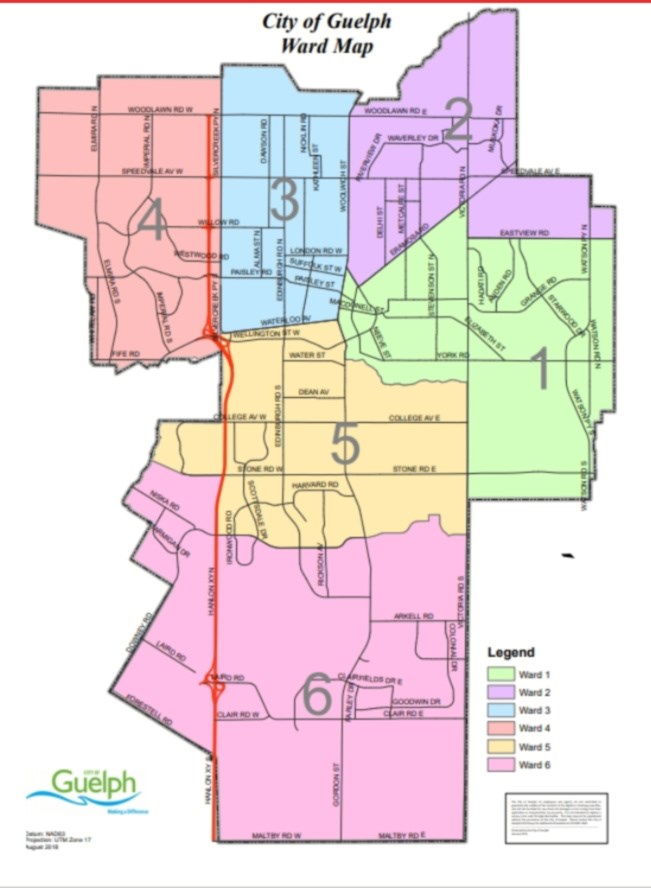It wasn’t the most controversial or talked about issue of the year, but it was finally settled last week by the Ontario Land Tribunal. That new ward map approved by city council this summer will be the map Guelph uses when we go to the polls next year.
To be frank, it’s unlikely to have any effect on what happens in 2022. The biggest change is that the dividing line between Wards 5 and 6 was moved slightly to south, adding 10,000 more people to Ward 5 and buying at least a couple of years for Ward 6 to again grow disproportionately larger in population relative to the rest of the wards.
This was the essential point of the appeal brought to the OLT by Alan Hall, who was a public delegate at meetings held on the new ward maps and has a lot of his own experience drawing election maps.
His argument in front of the OLT was that the six-ward map developed by the City of Guelph’s consultants was flawed by drawing a line at the Speed River and putting four wards to the north, and only two wards to the south.
Hall proposed a new six-ward map that would remix things by creating three northern wards, two southern wards, and a middle ward that would cover the area from downtown to the University of Guelph. In Hall’s estimation, his map would balance the relatively stagnant growth in the old parts of the city with the fairly rapid growth south of Stone Road.
Unfortunately, the hearings were not about the inadequacies of the new map, a map I would remind everyone comes about six years later than originally planned, and about 30 years after the City last redrew the lines.
Meanwhile, the city’s case presented at the OLT was that the process was excellent. Public engagement was off the chain, the consultants went back for round after round of feedback with all stakeholders, and the experience of the consultants themselves negates any accusation that they produced substandard results.
But Hall admitted to me that even he thought the consultants did a great job in the realm of public consultation. Their outreach wasn’t his issue, the map itself was.
There was a lot going on when this map was approved back in June so I didn’t get a chance to write about the debate at council that produced it. I’ve been banking some disgruntlement, and now is the time to unleash it. I apologize in advance for any offense.
First, let’s us cast off any pretense of complete objectivity on this matter as some councillors were probably worried about losing a statistical advantage. Going from 12 councillors to 8 means some people were going to lose their jobs, and the ones that were left were going to be getting full-time pay. Be honest, it was a consideration.
Second, it’s the devil you know. As now officially laid out, is Ward 3 that different a place than before? Or Ward 4? And I understand that there’s some upset downtown and in the Ward that they’re not in Ward 1 anymore but separating Wards 1 and 2 at Victoria Road is probably going to be a more elegant divide for councillors of a certain ideological point of view than before.
That ideological divide is probably part of the reason why the majority of council felt to at ease approving a map where areas in the south end are still disproportionately under-represented. There’s a popular point of view that the closer you get to Clair Road the more Guelph becomes just another GTA bedroom community, but that’s a gross misunderstanding of one of the more youthful and diverse areas of the city.
And if you don’t think there’s a north and south divide now, we might want to get prepared for what the future may bring. Elections Canada will be reviewing the boundaries of electoral districts in 2022, and it’s probably a good bet that Guelph will see some changes after escaping serious alternation after the last few reviews.
Might we see Guelph separated into two ridings and blended with some areas of Wellington County? It’s a serious possibility, and I wonder how people will react when the time comes. Will the same people who refused to accept the changing shape of the electorate locally in 2021 make a stink in 2022? Is splitting up Guelph because we’re just that big ruining our vaunted specialness?
There’s a hiccup in Guelph’s DNA. We’re at once a community that claims to be “future ready," but we’re also still hopelessly hung up on the way things used to be. The debate over the ward maps this year was an example of this. It’s hard to make a case you’re future ready when you ignore three decades of demographic change.
Ultimately, any appeal to the OLT was going to fail because you don’t just throw out a decision of municipal council because one guy objects. It’s too bad because those objections needed an airing in a venue where someone official could be divorced from our hopeless cause of nostalgia.
All I wanted for Christmas was an election map that makes sense of the 21st century. Maybe next term.
